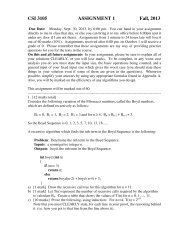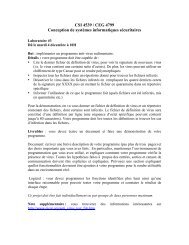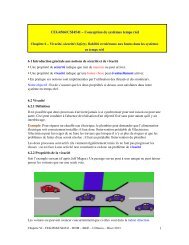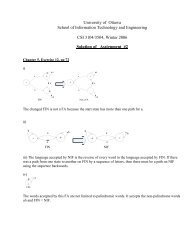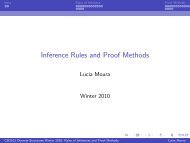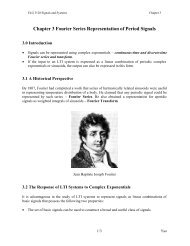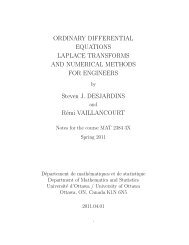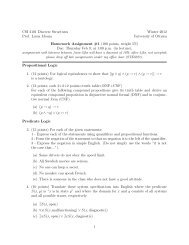CSI 2101 Discrete Structures Winter 2012 Prof. Lucia Moura ...
CSI 2101 Discrete Structures Winter 2012 Prof. Lucia Moura ...
CSI 2101 Discrete Structures Winter 2012 Prof. Lucia Moura ...
Create successful ePaper yourself
Turn your PDF publications into a flip-book with our unique Google optimized e-Paper software.
This argument is not true, and is the fallacy of confirming the consequent: Emma<br />
liking a restaurant is a necessary condition for a restaurant to be a fine restaurant,<br />
but it is not sufficient. Thus, we cannot conclude from the premises whether or<br />
not Le Cordon Bleu is a fine restaurant.<br />
9. (10 points) Give a formal proof, using known rules of inference, to establish the conclusion<br />
of the argument (3rd statement) using the first 2 statements as premises, where<br />
the domain of all quantifiers is the same.<br />
Remember that a formal proof is a sequence of steps, each with a reason noted beside<br />
it; each step is either a premise, or is obtained from previous steps using inference<br />
rules.<br />
• premise: ∀x(P (x) ∨ Q(x))<br />
• premise: ∀x((¬P (x) ∧ Q(x)) → R(x))<br />
• conclusion: ∀x(¬R(x) → P (x))<br />
Here is one possible formal proof:<br />
1. ∀x(P (x) ∨ Q(x)) premise<br />
2. ∀x((¬P (x) ∧ Q(x)) → R(x)) premise<br />
3. P (a) ∨ Q(a) for arbitrary a universal instantiation (1)<br />
4. (¬P (a) ∧ Q(a)) → R(a) universal instantiation (2)<br />
5. ¬(¬P (a) ∧ Q(a)) ∨ R(a) logical equivalence (4)<br />
6. (P (a) ∨ ¬Q(a)) ∨ R(a) DeMorgan (5)<br />
7. ¬Q(a) ∨ (P (a) ∨ R(a)) logical equivalence (6)<br />
8. P (a) ∨ (P (a) ∨ R(a)) resolution (3) and (7)<br />
9. P (a) ∨ R(a) idempotency (8)<br />
10. R(a) ∨ P (a) logical equivalence (9)<br />
11. ¬R(a) → P (a) for arbitrary a logical equivalence (10)<br />
12. ∀x(¬R(x) → P (x)) universal generalization (11)<br />
8



